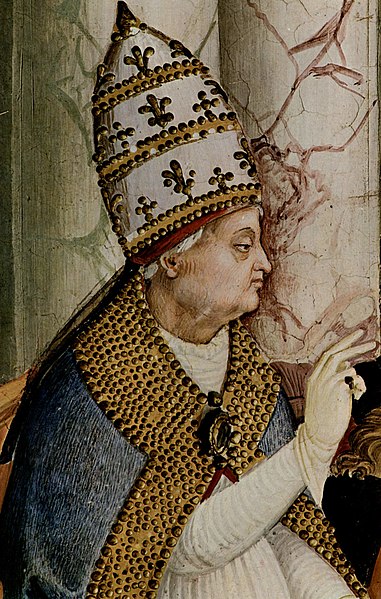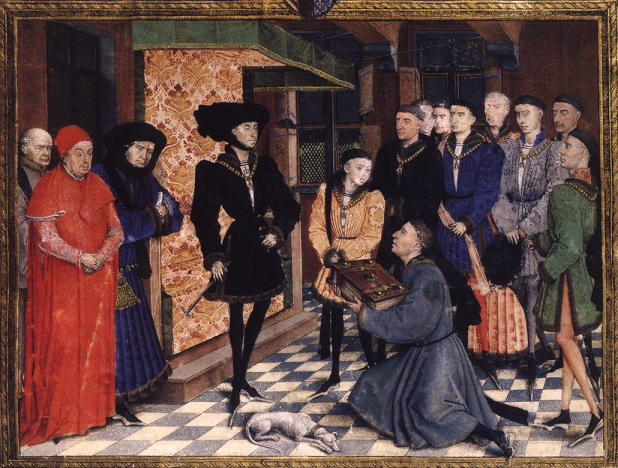 |
| Hue de Lannoy |
In May 1438
Hue de Lannoy led a Burgundian embassy to England to discuss matters of trade
and commerce. By August the question of a general peace, mediated by Burgundy
was on the table. The principal negotiator for the English was Cardinal
Beaufort once again, while Isabella was entrusted with speaking for the
Burgundians.
The first
conference was held in Gravelines in the summer of 1439; Isabella’s
quartermaster was in charge of preparing the scenery. Isabella arrived in St Omer in late May where she and Philip set up court for a long stay.
Charles VII
had agreed to send two of his daughters to Burgundy so that Philip could choose
one of them as a bride for his son. The older of the two princesses, the ten
year old Catherine was chosen and the couple were
formally betrothed on 14th June[i]. Catherine’s dowry was
properties located on the territories already ceded to Philip when he allied
with the French[ii].
In mid-June,
whilst involved in the negotiations Isabella received notice from the Chamber
of Accounts in Lille that there were a number of territorial officials who
were;
‘Allowing their accounts to
go to perdition.’[iii]
A furious
Isabella immediately wrote to demand that the responsible officials;
‘By return messenger present
to me at St Omer the reasons why this occurred and the necessary solutions.’[iv]
The
resultant information had to be sifted through and analysed at a time when
Isabella was involved in complex international affairs.
Her Finest Hour
 |
| Cardinal Beaufort |
Isabella met
with her uncle Cardinal Beaufort at the beginning of July at Calais, in
preparation for the conference. She was accompanied by Hue de Lannoy and two of
her counsellors, Jacques de Crèvecoeur[v] and Jean Chevrot. It was agreed that
Isabella would decide on the English delegates’ credentials while her uncle was
to do the same for the French delegates. Isabella was made responsible for
deciding how many armed men each delegate could bring to the conference which
opened on the 6th July.
One of
Isabella’s first tasks was to have the English delegates’ instructions amended,
deleting the assertions that English victories during the conflicts were the
results of God’s approval of English claims to the French throne. The French
refuted the idea that the English were entitled to the French throne (with or
without God’s endorsement).
Philip
remained at St Omer during the conference; Isabella kept him up to date with
daily messages reporting each day’s outcome. He would respond with his comments
and instructions. At one point Isabella returned to St Omer when Philip was
reported to be ill, she returned with a new peace plan which was turned down by
the English.
The only
outcome of the conference was a temporary truce, signed in September, between
the Burgundians and the English covering the area around Calais. The truce
covered trade, fishing, pilgrimage and finally;
‘A fine road to be marked
out through the dunes between Calais and Gravelines, passing north of the
castles of Marck and
Oye,
for the use of merchants of either side. But they are not to take dogs with them,
nor hunt for rabbits in the dunes.’[vi]
 |
| Chateau de Blois |
The French
and English were unable to agree on the vexed question of Henry VI’s title of ‘King of France’ and the war dragged on.
On 19th
May 1440 Catherine and Charles were married at Blois. As Catherine was only ten and Charles was seven the children lived
apart. Catherine lived with Isabella to be taught how to be a Duchess of
Burgundy. She was treated as a substitute daughter by her mother-in-law.
Catherine, who had a frail constitution found the Flemish weather did not suit
her and she was frequently sickly. However she followed Isabella on her
journeyings through the Burgundian holdings.
Chasing Peace
 |
| Pope Pius II |
Isabella was
determined to forge a separate peace with England and to that end began
preliminary talks with the English in Rouen, without Philip’s explicit
permission. It was rumoured that Philip allowed Isabella to do as she wished. Pope Pius II claimed of her;
‘This woman soon applied
herself to increasing her power and, exploiting her husband’s indulgence, she
began taking everything in hand, ruling the t0wns, organizing armies, levying
taxes on provinces and ruling everything in an arbitrary fashion.’[vii]
It was not
until 31st May 1443 that a letter signed by the Duke of York announced the Perpetual Treaty of
Peace. The treaty re-established peace between England and Burgundy and allowed
for increased trade.
Meanwhile
Charles VII was doing his best to undermine Philip’s imperial holdings. From
his base in Nancy Charles threatened Toul, Verdun and Metz. Charles also refused to allow Philip the special privileges his rank
entitled him to; allowing pardons or giving leniency to Philip’s Flemish
vassals in the Paris Parlement. Charles of Orléans was unable to soften his
cousin’s antagonism towards Burgundy, despite promising Isabella that he would
make the attempt.
 |
| Macon |
Philip
meanwhile was ramping up his demands for René of Anjou’s ransom even as French
troops attacked Flanders, Hainault and Picardy in the north while more attacks
were made on Mâcon and the imperial county of Burgundy.
At a meeting with the French Dauphin Louis in Laon Isabella was informed that the
French wanted to absorb Philip’s lands into France. France’s attitude towards
the Burgundians was sufficient to make many of the French supporting courtiers
to reconsider their sympathies. Isabella was more than ever convinced that the
secret of Burgundian security lay in an alliance with England.
Inter Family Rivalry
 |
| Philip (4th L) and Charles (5th L) |
As a senior
prince of the House of Valois[viii], Philip found it difficult to
believe that his relations desired the destruction of his inheritance. In 1445
Philip turned to Isabella to deal with the rift in Franco-Burgundian relations.
She travelled to Rheims to discuss a meeting in the summer. Burgundian demands
were for the French to cease;
·
Their
border raids on Burgundian territory
·
Pirate
raids on Burgundian shipping
·
And
to make reparations for the destruction of Burgundian villages and attacks on
Burgundian merchants.
At Chalons
in the summer Isabella was informed by the Marshal of Burgundy, Thibault de
Neuchâtel, that French atrocities continued despite the negotiations;
‘Many times we have notified
you of the damages done daily to your territories here by the écorcheurs[ix], daily they do
unimaginable things to Montbéliard.’[x]
The faction
at the French court who were pressing for the attacks on Burgundy were led by Queen Marie of Anjou, sister of René of Anjou, and René’s daughter Margaret, joint proponents for the Angevin[xi] faction. They wanted Philip to drop
his calls for the payment of René’s ransom which was one of Philip’s main
demands during the conference along with the confirmation of the Treaty of
Arras by the Dauphin and other notables who had unaccountably failed to do sign the document. Philip’s other demand
was for the French to leave Montbéliard.
All that
Isabella could negotiate from the French in return for dropping René’s ransom
was the promise to evacuate French troops from Montbéliard and a letter from
Charles (obtained after paying a bribe of 6,000 gold crowns[xii]) postponing cases in the
Paris parlement against Flemish merchants for non-payment of taxes and duty on
goods. The letter was thereafter ignored by the French who also refused to
fully ratify the treaty.
Bibliography
The Hundred
Years War – Alfred Burne, Folio Society 2005
The Reign of
Henry VI – RA Griffiths, Sutton Publishing Ltd 1998
Europe:
Hierarchy and Revolt 1320-1450 – George Holmes, Fontana 1984
The
Fifteenth Century – EF Jacob, Oxford University Press 1997
Margaret of
Anjou – Helen E Maurer, Boydell Press 2003
Isabel of
Burgundy – Aline S Taylor, Madison Books 2001
Philip the
Good – Richard Vaughan, Boydell Press 2014
Charles the
Bold – Richard Vaughan, Boydell Press 2002
www.wikipedia.en
[i]
The engagement lulled the Burgundians into a false sense of security
[ii]
Charles had the option to buy back the territory and that buyback increased in
value with the marriage to 520,000 eçus; In 2015 the relative: historic standard of
living value of that income or
wealth is £281,000,000.00 labour earnings of
that income or wealth is £3,054,000,000.00 economic status value of that income or wealth is £9,609,000,000.00 economic power value of that income or wealth is £175,200,000,000.00.
www.measuringworth.com Charles
could not afford the buyback as his treasury was empty and any monies he had
were spent fighting the English
[iii]
Isabella of Burgundy - Taylor
[iv]
Ibid
[vi]
Philip the Good - Vaughan
[vii]
Isabel of Burgundy - Taylor
[ix]
Flayers – whether this was meant literally or whether Neufchâtel meant that
they were flaying the countryside is not known
[x]
Isabel of Burgundy - Taylor
[xi]
Another junior branch of the House of Valois
[xii]
In 2015
the relative: historic standard of living value of that income or wealth is £4,818,000.00 labour earnings of that income or wealth is £35,400,000.00 economic status value of that income or wealth is £169,700,000.00 economic power value of that income or wealth is £3,150,000,000.00 www.measuringworth.com
No comments:
Post a Comment
Note: only a member of this blog may post a comment.